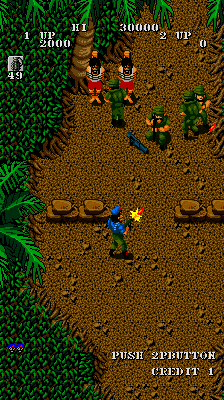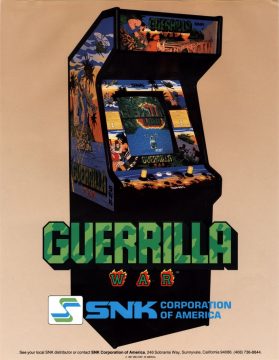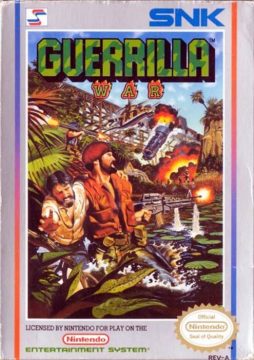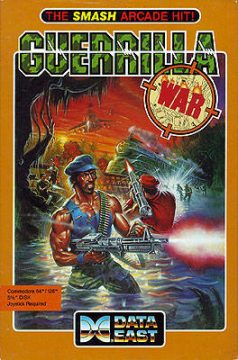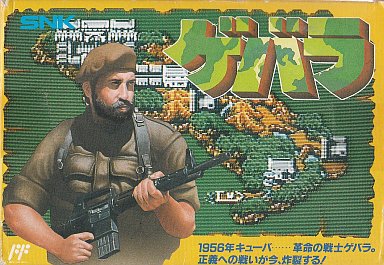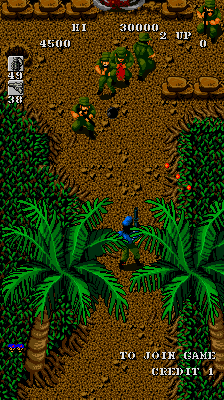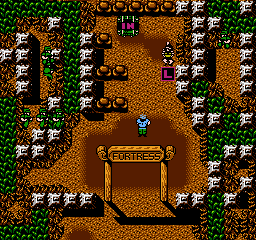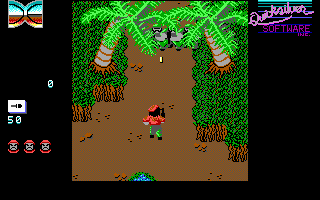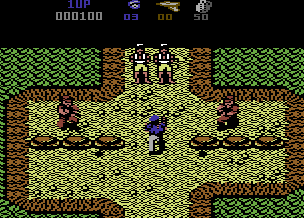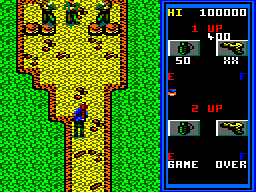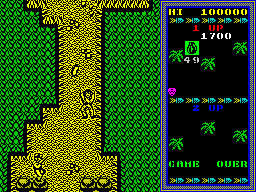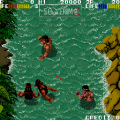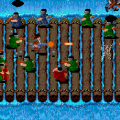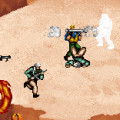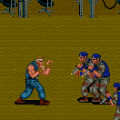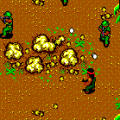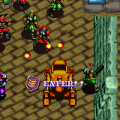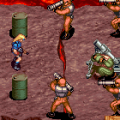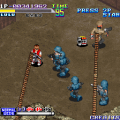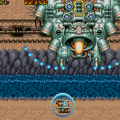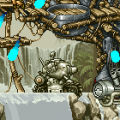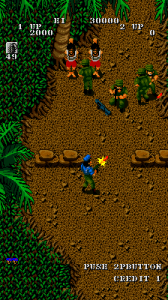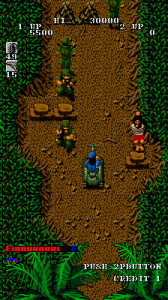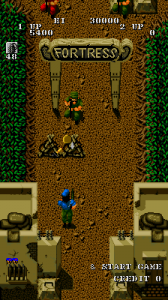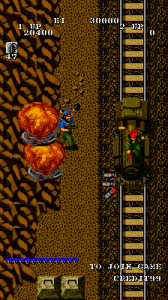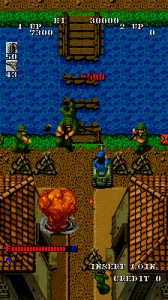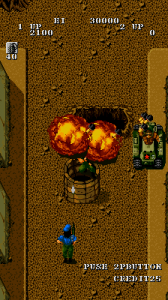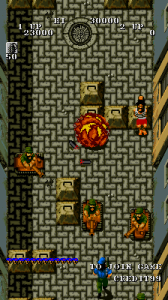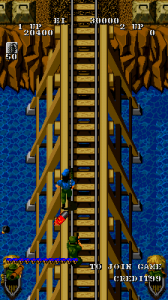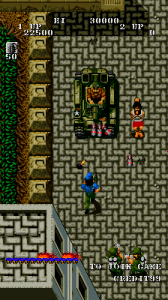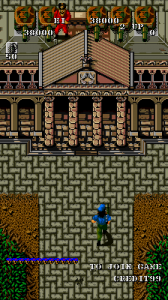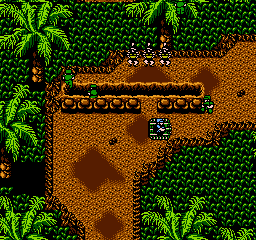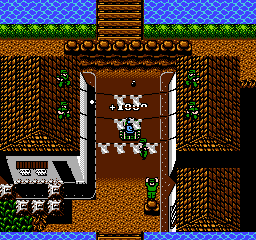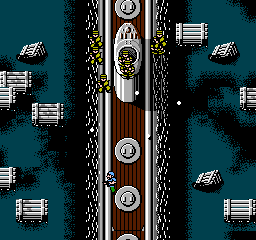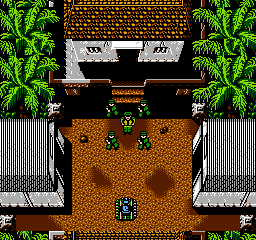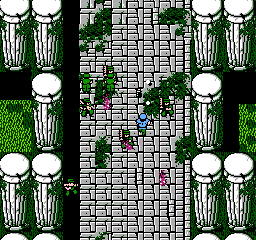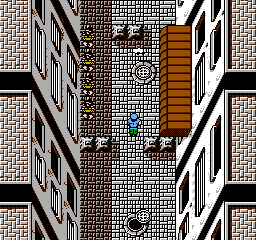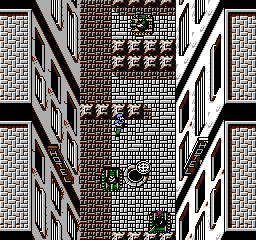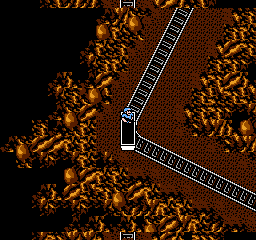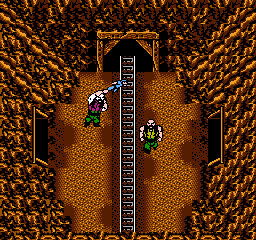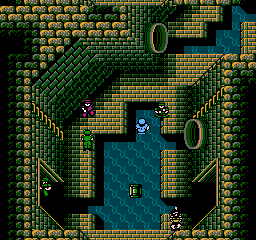Ikari Warriors was one of SNK’s earlier titles that gained them a reasonable amount of popularity, even if it was ripping off the premise of Capcom’s Commando. It nonetheless had its own ideas, particularly the rotating joystick which allowed the player to move in one direction while firing in another, and the ability to hijack tanks and wreak havoc before they were inevitably hit by explosives. The sequel, Victory Road, was essentially the same game but in space and with new weapons, and things went in an entirely different direction with Ikari III, which was made into an awkward overhead beat-em-up with fists taking priority over guns. Sometime between the decidedly stranger second and third games was the release of a technically unrelated run-and-gun which was closer in spirit to the first Ikari Warriors and perhaps felt more like a sequel than the latter two Ikari games. However, it was also given a slight historical twist in which the main protagonist is none other than Ernesto “Che” Guevara.
More than just the commonly-used image of an unshaven guy in a beret on shirts that punk kids wear, Che was a guerrilla commander and key figure in the Cuban Revolution, in which insurgents led a two-year civil war that eventually deposed Fulgencio Batista, the then-dictator of Cuba. Some think of him today as a courageous icon of righteous rebellion, while others believe he was a savage warmonger who did more damage than good. Regardless of SNK’s unknown opinions on Che, they released this game, simply titled Guevara, where player one gets to be Che alongside a potential player two, who is none other than Che’s good friend, brother-in-arms, and incredibly divisive former President of Cuba, Fidel Castro. Needless to say, the incredibly touchy subject matter would have made it a pretty dang controversial release outside of Japan, particularly in the American gaming market. For those who may not be familiar with American-Cuban relations, they have been long been uncomfortably delicate. With Japan not having much political investment in this matter but SNK finding the subject matter fascinating, they realized that any game which portrayed Che and Fidel as heroic in any capacity would have been obliterated by patriotic critics. Thus, they removed any mention of the protagonists’ real identities and simply renamed the world release Guerrilla War.
Setting aside all of its touchy history, Guerrilla War itself is quite a fun game. It starts with a picture of Che and the amusing caption, “Hail the heros [sic] of the revolution!” After Che and/or Fidel ride their boat to a beachfront narrowly avoiding bomber planes, they begin their fight to overthrow a dictator which may or may not be Batista. The gameplay is incredibly akin to Ikari Warriors, so much that it may as well be considered part of the series even if only in spirit. You have a rotating joystick which allows you to walk and turn with both actions independent of each other, an effect sadly lost on modern emulators which attempt to compromise by setting the rotating effect to two keys, which is certainly not quite the game. One button fires off your rifle while the other tosses grenades; grenades are limited to fifty per life (which is still a lot), but unlike IW, rifle ammo is conveniently unlimited. It’s still wise to mind your shots, as you run the risk of hitting prisoners of war, cruelly tied up and stuck on the battlefront by the enemy regime. You get 1000 points if you run in and rescue them, but 500 points are deducted for each victim you accidentally shoot.
The enemy resistance is primarily comprised of green soldiers who either shoot at you or toss out grenades, as well as set up barricades that you must try to destroy with your own grenades. There’s not an incredibly high amount of variety, but the game inundates you with soldiers at every turn, even in the early levels. You’ll have some soldiers blasting out bazookas and riding tanks, but turnabout is fair play and, as in Ikari Warriors, you can find tanks to use against the enemy. Take advantage of this time to run over everyone and blast them with your turret until an explosive dings it and you’ll have to bail, which is likely to happen unless you’re a savvy aimer. Outside of the tank, you can also find powerups from rare red-clad soldiers to give you more powerful weapons (bazookas, flamethrowers, etc) that come with limited ammo but can give you an advantage against targets which take more damage.
You’ll need any advantage you can get, as GW is rather “arcadey” with its difficulty. You can continue as long as you have the credits to back it up, but it’ll take a lot of money for the average player to get through the entirety of it. It’s quite a short game at only five levels, each one usually about five minutes on average, but you usually get flooded with enemy soldiers who run in, fire a shot or toss a bomb, and then flee afterward. Each of the five stages also ends with a boss fight wherein you must dismantle a vehicle (often with a high-ranking officer who constantly laughs at you piloting them), ranging from helicopters to large tanks and even an armored train which can somehow move back and forth across the rail. These vehicles are only damageable by your grenades which can be hard to aim on moving targets while under pressure of intense fire. Whether or not they’re more difficult than the barrage of enemies is up for debate, but while GW can be beaten if patient, it’ll be a costly endeavor. Even attempting to get as far as you can on a one-credit run is likely to end before the first level’s conclusion. Regardless, at least Guerrilla War allows gamers to play to the end, unlike Ikari Warriors which only allowed on-the-spot continuing in two-player games.
So the gameplay is quite straightforward, as is its appearance depicting an anonymous island nation which is most likely Cuba. The graphics for a 1987 game were a slight cut above standard and decidedly good, even if 95% of all colors belong to different shades of brown, green, and blue, with some gray seeping into later levels. The Central American jungle setting for most locales doesn’t allow for a lot of variety, but the settings at least look bright and vibrant, at least compared to Ikari Warriors‘ dark and somewhat muddy-looking jungle. Later levels go through cityscapes with stone roads, but that’s usually as varied as visual setups get. If nothing else, it’s a decent representation of how Cuba would have looked during the revolution, or at least as close as a video game of the time could have come. Amplifying the atmosphere is a number of clear voice clips which are usually used for death yells, sadistic laughter, and bricklayers shouting out “heave-ho.” In contrast, there’s really not a lot to say about the music, as its volume is usually a bit low compared to all the explosions and screams rising out from the speakers. What’s there is adequate but unmemorable, certainly nothing as prominent as Ikari Warriors‘ main theme.
Guerrilla War is an incredibly base game that doesn’t even pretend to be anything besides what it is: A Central American renegade commando rampage of violence. It is admittedly a bit cheap with all the times you will be dying, but taking it for what it is, it at least stands out as one of the better examples of the on-foot run-and-gun subgenre of shoot-em-ups popularized by Capcom’s Commando. While Ikari Warriors attempted to rival Commando‘s popularity, Guerrilla War turned out as a better example of what IW was trying to do but didn’t quite accomplish; it was a bit slow and awkward, but GW turned up the speed and made for a more cohesive experience, yet it ironically turned out as the more obscure game. Ikari Warriors went on to create two sequels and star its protagonists, Ralf and Clark, as two of the more recognizable players in the Neo Geo’s flagship King of Fighters series, who would even star in the later installments of the Metal Slug sidescrolling shooter series.
Guerrilla War, however, remained in the darkness fairly soon after its release, and while conjecture, the game’s real-life ties may have been reason for SNK minimizing its potential continuation. The references to Che Guevara and Fidel Castro could have been easily removed and the game would still be what it was, but admittedly, the dire history behind Guevara is what makes it one of SNK’s more interesting (if lesser known) games. Some may see it as insensitive, but for better or worse, the glorification of war has always been a component floating around video game production ever since the days of Atari’s “Combat” and continues today with a staggering amount of first person shooters based on both real and fictional conflicts. Guerrilla War is especially curious due to how absolutely heroic it portrays its protagonists, two of the most divisive figures in world history and one of which who (as of this writing) is still alive. The game might be written off as “just another shooter” were it not for its historical basis, and its unlikely setting combined with improved gameplay over its spiritual predecessor make Guerrilla War a game worth checking out, regardless of any sentiments towards El Che.
Like many action games of the time, Guerrilla War did at least make enough of a splash to warrant several home ports, mostly to various computers and nearly all of which were inferior. The Amstrad CPC version does a decent job with colors, but the action is incredibly slow at a low framerate. The Commodore 64 rendition is also pretty slow but at least moves a bit smoother, yet your player character seems outmatched against the enemies’ fast projectiles. The ZX Spectrum version moves faster, but its low-end graphics make it hard to see deadly bullets and grenades travelling over the terrain. The DOS version plays slightly better than the other computers, but the graphics are horribly laughable seeing how the player characters and enemies have gray skin and constant cartoony scowls, and grating PC speaker music plays throughout your game that’ll likely have you reaching for a mute volume setting on your machine.
Amidst all the standard computer ports which attempted to replicate the original and often failed to capture the magic, the NES port stands out as the most unique for having done something different. It focuses less on copying the arcade version and more on delivering its own experience, similar to what the first two Ikari Warriors games attempted but much less abominable. If anything, the NES version may be more preferable for its increased length and content, as well as keeping the action far more manageable and less ridiculous. It moves even faster than the arcade game with Che and Fidel rolling along at a decent trot and carrying infinite grenades. There are a few more weapons to grab, like tri-pellet shotguns and missiles which burst into bullets on impact, and they’re also in limitless supply until the next player death.
The game starts out mostly the same for the first few levels before it detours into new locales, such as a fight on a large submarine, a dreaded sewer level, and an underground stage with a bizarre bonus segment where you must save prisoners with a lasso while riding a minecart, a scene which exhibits some surprising rotation effects for the NES hardware. There’s enough new content to effectively double the original arcade game’s length into a solid ten levels, yet it doesn’t feel like it’s bloating the game up with wasted stages but rather adding to the experience and making for a meatier overall run-and-gun deathfest. It also features bright graphics that are even more colorful than the arcade version, and the music is actually quite good this time around, featuring energetic tunes made to go with shooting enemy commandos. It couldn’t replicate the rotating joystick independent fire of the arcade, but it works just as well to simply fire in the direction you’re currently running and keeps things overall simpler.
If there’s any one possible fault, it’s that you have absolutely unlimited continues and can just power your way through the game without really doing any good at it. If you try to play it straight, it’s not a challenging game, but if you’re playing to keep a tally of your score and/or how many continues you use, it becomes quite vicious and can make for a tough point trial. Whatever the case, Guerrilla War on the NES is one of the finest examples of an overhead run-and-gun on the system, and it helps that it was actually developed by SNK themselves instead of notorious shadow developer Micronics, infamous for some of the worst arcade-to-home conversions on the NES including Ikari Warriors. While SNK still had a few years to reach mega-fame with the Neo Geo, Guerrilla War was one of their finer pre-nineties games and doubly so on the little gray box.
Screenshot Comparisons
